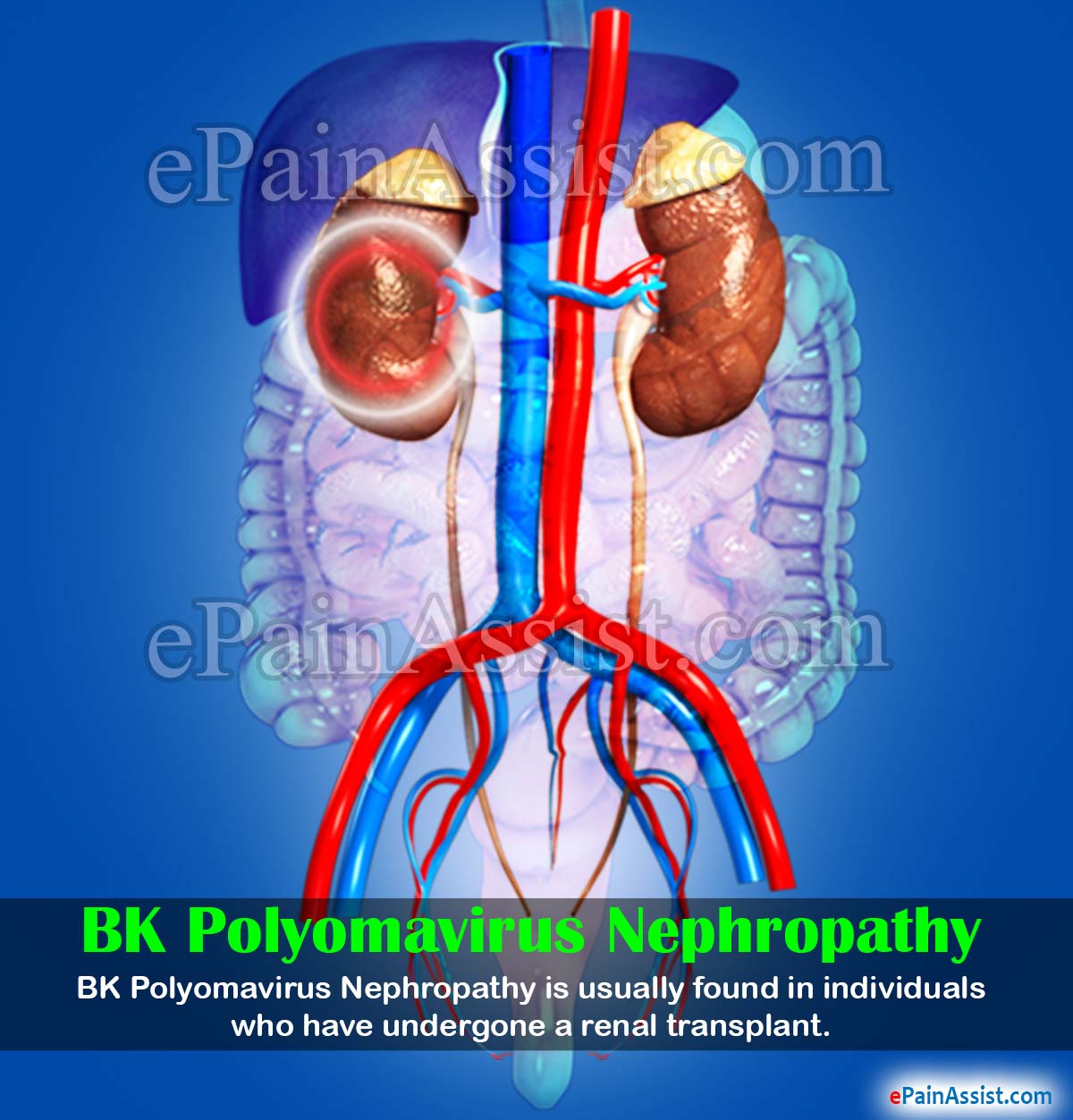BK Polyoma Virus- This virus is a member of the polyomavirus family. It usually does not cause any infection and is relatively asymptomatic. The virus become active and causes infection when there is an immunocompromised state in the body. Infection of the immunosuppressed kidney results in a pathological condition called BK Polyomavirus Nephropathy. In this article, we will discuss about the various aspects of BK Polyomavirus Nephropathy.

How Is BK Polyoma Virus Nephropathy Defined?
- Polyoma Virus1– As stated, the BK virus is a member of polyomavirus family.
- Latent Form- The BK Polyomavirus is not known to cause any significant infection and is usually a latent form of virus.
- Dormant Virus- The virus inhabits as a dormant virus in the tissue of kidney and urinary tract for the rest of the life of the individual. Researchers are of the belief that up to 80% of people has this virus, which remains silent up until the body has some form of immunosuppression issue.
- Non-Infectious Stage- The virus is non infectious until the individuals immunity is compromised.
- Immunosuppress Patient- Virus becomes active in individual who is immunosuppressed and immunocompromised. BK virus causes nephropathy in immunosuppress individuals.
- Renal Allograft Failure- BK virus nephropathy is a major cause of renal allograft failure.2
Causes of BK Polyoma Virus Nephropathy
Kidney Transplant Patient-
- BK Polyomavirus Nephropathy is usually found in individuals who have undergone a renal transplant.
- The use of immunosuppressive medications in these individuals allows this virus to replicate within the graft resulting in BK Polyomavirus Nephropathy.
- Literature states that around 10% of renal transplant patients’ ends up having BK Polyoma virus nephropathy and around 85% of these patients end up losing their grafts.
- The onset of BK Polyomavirus Nephropathy is as early as a week after transplant to as late as 6-7 years.
- BK Polyomavirus Nephropathy is also known to be associated with ureteral stenosis and interstitial nephritis.
Native Kidney3
- Dormant virus may cause infection in normal kidney though the cause is not known.

Symptoms of BK Polyoma Virus Nephropathy4
Non-Specific Symptoms of BK Polyoma Virus Nephropathy:
- Fever
- Weight loss
- Loss of appetite
- Sweating
Specific Symptoms of BK Polyoma Virus Nephropathy:
Nephropathy and Hydronephrosis
- Urine Volume- low
- Urine Color-
- Turbulent (proteinuria) and
- Reddish discolor (hematuria)
- Pain
Ureteric Obstruction
- Low urine volume
- Lower back pain
Cystitis
- Lower abdominal pain
- Hematuria
Diagnosis of BK Polyoma Virus Nephropathy
Blood Examination
- Microscopic Examination- Decoy cells are seen
- BKV specific antibody test- Positive antibodies are found during active infection.
- BKV DNA is positive in plasma
- Blood Urea Nitrogen- Elevated or normal
- Creatinine- Elevated or normal
Urine Examination
- Microscopic Examination- Decoy cell, renal tubular cells and inflammatory cells are observed.
- Proteinuria
- Hematuria- RBC’s in urine
Renal Biopsy
- Focal lesion observed during earlier stage.
- Minimal inflammatory changes and mostly fibrotic changes are observed.
- Other findings are as follows-
- Interstitial mononuclear inflammatory cell infiltrates seen spread in lesion
- Plasma cells are seen
- Necrotic tubular epithelium are seen
Viral Culture
- BK Polyoma virus are identified in serum culture
- Blood polymerase chain reaction (PCR)- positive during viral infection phase.
CT Scan-
- Kidney shows signs of Hydronephrosis
Treatment for BK Polyoma Virus Nephropathy
Early Diagnosis and Treatment5–
- Best treatment is early diagnosis following kidney transplant.z
- Reverse immunosuppression
- Treat with antiviral medication
- Frequent blood test during follow up period
Treat Immunosuppression-
- The frontline treatment for BK Polyomavirus Nephropathy is to correct the immunosuppression.
- BK Polyomavirus Nephropathy usually occurs with the use of immunosuppressant medications like Tacrolimus and mycophenolate mofetil.
- BK Polyomavirus Nephropathy is usually not caused by administration of a single immunosuppressant medication, but is related to overall immunosuppressive load.
Antiviral Medications-
- Ciprofloxacin is shown to significantly reduce the viral loads
- Cidofovir
- Leflunomide.
Immunoglobulin Therapy-
- Intravenous immunoglobulin therapy has been used to treat infections and allograft rejection
- Gamma globulin correct immunosuppression and prevent graft rejection.
- Update on human polyomavirus BK nephropathy.
Cimbaluk D1, Pitelka L, Kluskens L, Gattuso P.
Diagn Cytopathol. 2009 Oct;37(10):773-9. - BK polyomavirus nephropathy complicated with acute T-cell-mediated rejection in a kidney transplant recipient: a case report.
Tanabe T1, Shimizu T, Sai K, Miyauchi Y, Shirakawa H, Ishida H, Honda K, Koike J, Yamaguchi Y, Tanabe K.
Clin Transplant. 2011 Jul;25 Suppl 23:39-43. - BK polyoma virus nephropathy in the native kidney.
Sharma SG1, Nickeleit V, Herlitz LC, de Gonzalez AK, Stokes MB, Singh HK, Markowitz GS, D’Agati VD.
Nephrol Dial Transplant. 2013 Mar;28(3):620-31. - BK virus infection: an update on diagnosis and treatment.
Sawinski D1, Goral S.
Nephrol Dial Transplant. 2014 Feb 25. - Monitoring and treatment for BK virus after kidney transplantation.
Moon HH1, Kim TS, Lee S, Song S, Shin M, Park JB, Kim JM, Kwon CH, Joh JW, Lee SK, Kim SJ.
Transplant Proc. 2013 Oct;45(8):2980-3.
